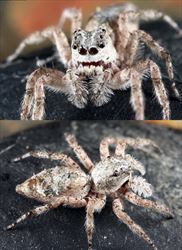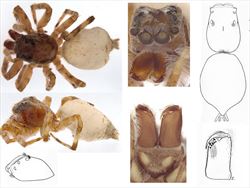
Examples of live Mintonia
Illustrator (and ©) I.R. Macaulay

Aspects of the general morphology of Mintonia
Illustrators (and ©) B.J. Richardson (CSIRO), M. Zabka (diag.) (QMB)

Palp morphology of Mintonia
Illustrator (and ©) M. Zabka (diag.) (QMB)

Epigyne morphology of Mintonia
Illustrators (and ©) B.J. Richardson (CSIRO), M. Zabka (diag.) (QMB)
Mintonia Wanless, 1984
Taxonomy
Mintonia is found mostly in Borneo and surrounding islands. A single undescribed species occurs in Australia. Other genera belonging to the same Old World group with Australian representatives are Cocalus, Cyrba and Portia (Maddison 2015).
Description
Mintonia spp. are medium-sized spiders, body length about 9 mm. The head, viewed from above, is pear-shaped, widest behind the posterior lateral eyes. A cleft down the length of the cephalothorax creates the appearance that the lateral eyes are on raised mounds, one on each side. The abdomen is round, ending in a pointed protuberance. The legs are of medium length and quite strongly built. The chelicerae each have five retromarginal teeth (plurident).
The male’s palp is elliptical, longer than wide, without a proximal lobe and with a ledge on the side of the tegulum. The sperm duct encircles the tegulum. The embolus is short and slender, arising on the distal edge of the tegulum, the tip resting on an associated sclerite. The retro-lateral and ventral tibial apophyses are well-developed, the retro-lateral being long and spinelike.
Females have a single epigynal atrium with weakly sclerotised edges. The anterior-facing copulatory openings are near the posterior edge of the atrium. The closely adjoining insemination ducts enter the anterior edges of the spermathecae. Large, rounded spermathecae lie between the atrium and the epigastric fold.
Biology
Mintonia has been collected in rainforest, sometimes under bark.
Distribution
Mintonia is found in tropical Australia from Iron Range to Townsville, Queensland.
References
Davies, V.T. & Żabka, M. 1989. Illustrated keys to the genera of jumping spiders (Araneae: Salticidae) in Australia. Memoirs of the Queensland Museum 27, 189-266.
Richardson, B.J. & Żabka , M. 2016. Salticidae. Arachnida: Araneomorphae. Canberra, Australian Faunal Directory. Australian Biological Resources Study, at https://biodiversity.org.au/afd/taxa/SALTICIDAE.
Wanless, F.R. 1984. A revision of the spider subfamily Spartaeinae nom. n. (Araneae: Salticidae) with descriptions of six new genera. Bulletin of the British Museum (Natural History) Zoology 46, 135-204.
* The information sheet should be interpreted in the context of the associated diagrams and photographs. Diagrams explaining anatomical terms can be found in the ‘Salticidae’ pictures at the beginning of the list of genera.